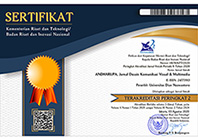ANALISIS DESAIN KARAKTER MAKHLUK FOLKLORE DARI JEPANG DALAM BUKU CERITA ANAK BERGAMBAR
Abstract
Abstrak
Indonesia memiliki berbagai jenis makhluk mitologi dalam cerita rakyat yang merupakan bagian dari budaya Indonesia. Karakter makhluk mitologi ini kerap diceritakan dalam cerita rakyat yang sampai sekarang diadaptasi menjadi berbagai format kontemporer salah satunya ke dalam buku cerita anak. Namun, pengaplikasian karakter dalam cerita rakyat tersebut cenderung kuno dan monoton dari buku satu ke buku lainnya. Sebagai perbandingannya, Jepang yang juga memiliki berbagai macam karakter budaya dalam cerita rakyatnya dapat mengadaptasi karakter makhluk mitologi tersebut ke dalam cerita dengan tema yang lebih kontemporer. Untuk itu, penulis melakukan kajian mengenai desain karakter makhluk folklore dalam buku cerita anak Jepang yang memuat tema kontemporer. Tujuan penelitian ini adalah untuk mengidentifikasi dan memahami elemen dalam membangun desain karakter berdasarkan makhluk mitologi dan membuat suatu konsep berdasarkan hal tersebut. Penelitian menggunakan metode kualitatif dengan pendekatan studi kasus karakter desain dalam buku anak Jepang dengan tema folklore kontemporer. Kemudian peneliti membandingkan dengan desain referensi aslinya menggunakan teori manga matriks dan RWD (Ruang, Waktu, Datar). Hasil dari penelitian ini kemudian dapat digunakan sebagai acuan bagi ilustrator maupun penulis cerita untuk lebih menggunakan karakter dari tradisi dan budaya Indonesia ke dalam bentuk cerita sebagai salah satu upaya pelestarian budaya dan cerita rakyat di Indonesia.
Kata Kunci: desain karakter, buku bergambar, cerita rakyat kontemporer, makhluk mitologi
Abstract
Indonesia has varieties of mythological creatures based on the local Indonesian folktales. Nowadays these characters are often introduced inside stories, games, or other contemporary media and one of them is children’s picture books. Sadly, the implementation of these cultural characters were monotonous and redundant from one book to another. As a case study, Japan has similar cultures regarding folktale with Indonesia and has implemented the essence of those characters into more contemporary themed stories. From these findings, the writer delivered qualitative research to study Japanese picture book’s character designs with contemporary themes. The purpose of this research is to identify and understand the elements in building character designs based on mythological creatures and create a concept based on them. The research uses a qualitative method with a case study approach to character designs in Japanese children's books with the theme of contemporary folklore. Then the researcher compared it with the original reference design using matrix manga theory and RWD. Findings from this research may be used as reference for both Indonesian writer and illustrator to create stories and designs based on Indonesian’s characters from folktales as a way to preserve Indonesian’s folktales.
Keywords: character design, contemporary folktale, mythological creature, picture book
Full Text:
PDFReferences
Ahmad, H. A., & Soo-Min, L. (2009). Telling Stories using Children ’ s Visual Language. IASDR 2009: Design | Rigor & Relevance, 1207–1214.
AygülAygün, & OyaAbac?. (2014). Examination of illustrated story books published between the years of 2004-201for 4-8 age group children in terms of illustration, 152, 94–99.
Cresswell, J. W. (2013). Qualitative inquiry and research design : choosing among five approaches. United States of America: SAGE Publications, Inc.
Danandjaja, J. (1995). A Comparative Study of Japanese and Indonesian Folklores. Southeast Asian Studies, 33(3), 484–496.
Foster, M. D. (2015). The Book of Yokai: Mysterious Creatures of Japanese Folklore. California: University of California Press.
Hermanto, Y. A. L. (2019). Visual Storytelling in Folklore Children Book Illustration. In Proceeding: International Conference on Interdisciplinary, Social Science, Business, Technology and Education (ISBTEC 2019) (pp. 1–10).
Iskandar, M., & Nurusholih, S. (2019). “Lacerman” Comic Character Design With Morphological Forced Connection Method (Mfc). Balong International Journal of Design Vol.2.No.2, 2(2), 84–93.
Köse, S., & Ar?kan, D. (2020). The Effects of Cartoon Assisted Endoscopy Preparation Package on Children â€TM s Fear and Anxiety Levels and Parental Satisfaction in Turkey, 53, 72–79.
Leeming, D. (2001). A Dictionary of Asian Mythology. New York: Oxford University Press, Inc.
Maru, M. G., Tulus, A., Dukut, E. M., Liando, N., Mangare, J. G., & Mamentu, A. C. (2018). Children ’ s Story Books : Introducing Cultural Hybridity , Shaping Intercultural Sensitivity for Foreign Language Young Learners ( An Observation to Gramedia Books in 2017 ). In Social Science, Education and Humanities Research. 1st International Conference on Social Sciences (ICSS 2018) (Vol. 226, pp. 894–899). Atlantis Press.
Purwaningsih, D. A. (2018). Character Design In Indonesian Animated Series : Escaping The Shadow Of Foreign. Ultimart: Jurnal Komunikasi Visual, 9(2), 48–60.
Retnowati, G., Mini, R., Salim, A., & Saleh, A. Y. (2018). Effectiveness of Picture Story Books Reading to Increase Kindness in Children Aged 5-6 Years. Lingua Cultura, 12(1), 89–95.
Sartini. (2004). Menggali Kearifan Lokal Nusantara Sebuah Kajian Filsafati. Jurnal Filsafat, 14, 111–120.
Utami, A. D., Fleer, M., & Li, L. (2021). Learning , Culture and Social Interaction An analysis of a child ’ s experiences in playing a gendered character during playworld. Learning, Culture and Social Interaction, 28(September 2020)
DOI: https://doi.org/10.33633/andharupa.v8i01.4655
Article Metrics
Abstract view : 873 timesPDF - 832 times
Refbacks
- There are currently no refbacks.
indexed by:
Andharupa Journal (p-ISSN: 2477 - 2852 | e-ISSN: 2477 - 3913) is published by Dian Nuswantoro University, Semarang. This Journal is licensed under Creative Commons Attribution 4.0 International License.
























